
Text by Nicole Bouglouan
Photographers:
Didier Buysse
Vision d’Oiseaux
Callie de Wet
GALLERY
Jean Michel Fenerole
Photos d’Oiseaux du monde
Steve Garvie
RAINBIRDER Photo galleries
Jean-Claude Jamoulle
A la rencontre des Oiseaux
Otto Plantema
Trips around the world
William Price
PBase-tereksandpiper & Flickr William Price
Dubi Shapiro
Dubi Shapiro Photo Galleries
Stapelberg Philip
GALLERY
Alan & Ann Tate
AA Bird Photography
Sources:
HANDBOOK OF THE BIRDS OF THE WORLD Vol 15 by Josep del Hoyo-Andrew Elliot-David Christie - Lynx Edicions – ISBN: 9788496553682
ROBERTS BIRDS OF SOUTH AFRICA by G. R. Mc Lachlan and R. Liversidge – The Trustees of the John Voelcker Bird Book Fund – ISBN: 0620031182
The Birds of Africa: Volume VII – C. Hilary Fry, Stuart Keith – Editeur: Bloomsbury Publishing, 2020 – ISBN: 1472986563, 9781472986566 – 724 pages
The Birds of Africa: Volume VIII: The Malagasy Region: Madagascar, Seychelles, Comoros, Mascarenes - Par Roger Safford, Frank Hawkins – ISBN: 1408190494, 9781408190494- Editeur: A&C Black, 2013
CREAGUS@Monterey Bay (Don Roberson)
SORA - WEAVERBIRD NEST AGGREGATION AND EVOLUTION OF THE COMPOUND NEST
Repeatability of nest morphology in African weaver birds
11 Interesting Facts about Sociable Weavers
Weaver Watch - Monitoring the Weavers of the World
Fatbirder - The World’s Richest Information Resource about Birds for Birders
Wikipedia, the free encyclopaedia
FAMILY PLOCEIDAE
Fourth part (courtship behaviour - nests- predation - status)
Weavers, sparrow-weavers, bishops, widowbirds, fodies, malimbes, queleas …
The genus Ploceus is the most important of the family Ploceidae.
In order to attract females, the male Cape Weaver of genus Ploceus builds several nests, and then, it gives advertising calls. The male builds the nests which will be used as a display to lure females. It may hang upside down at the base of the nest, flapping its wings and swaying from side to side. These displays are accompanied by excited call.
The male is polygamous with more than one mate. They nest in large colonies, as in reedbeds or in trees, close to dams and farmlands.

The Village Weaver male displays when the nest is built. It hangs from the nest base upside down and with fluttering wings while calling. The breeding season varies according to the place, but in Central Africa, it continues throughout the year.
The Village Weaver is, at first, monogamous, becoming polygamous later. The male begins the breeding season with one female, and it may find other female to mate with.
After the first nest is built and while the first female is incubating, the male builds another nest and tries to attract another female. One male may have up to five mates in five nests. Each male displays at its last nest with an individual distinctive call.
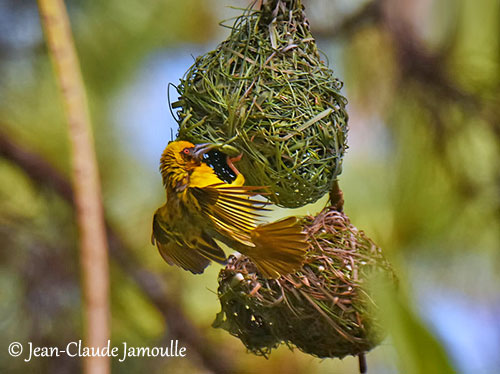
Ploceus cucullatus
The Lesser-masked Weaver is polygynous with 2-3 females. It is colonial-nester, but with only 20-30 to 60 nests, and rarely more than 200 nests.
The male builds the nest, a kidney-shaped structure with a downward-pointed entrance tunnel of about 5 centimetres long.
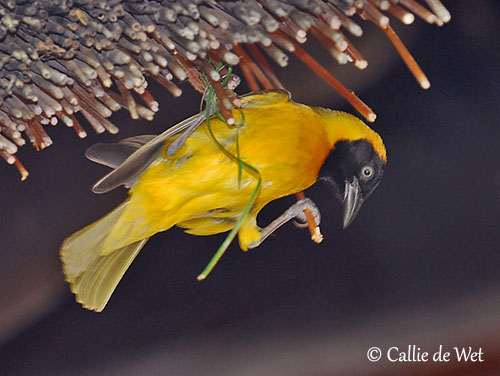
Lesser-masked Weaver
Ploceus intermedius
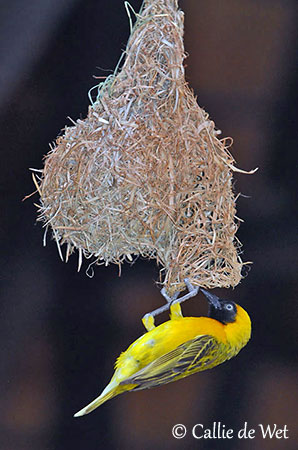
Lesser-masked Weaver
Ploceus intermedius
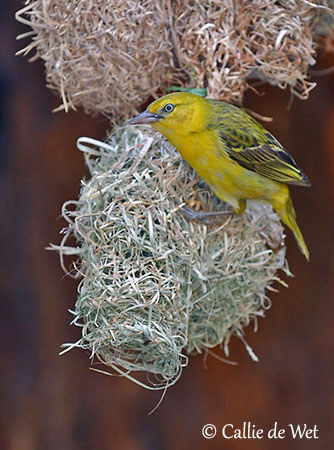
Lesser-masked Weaver
Ploceus intermedius
Female
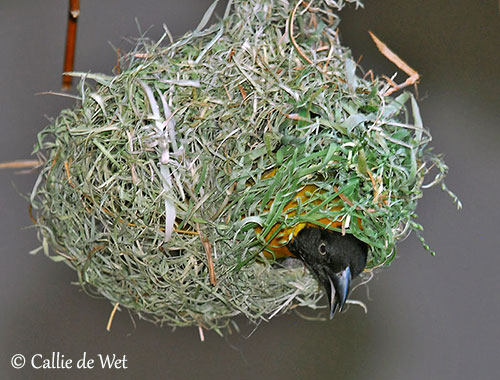
Lesser-masked Weaver
Ploceus intermedius
The Sakalava Weaver is found on Madagascar. It is a colonial nester, and the colonies are established from several years and are regularly reused.
The courtship displays are poorly known. The male frequently courts any passing females, even while feeding the chicks. The displays include drooping and wing-fluttering when the male approaches a female. It sometimes carries nest material that will be added to the nest entrance. The female often escapes into the nest, but the male rarely ventures into the hanging structure.
When the nest is almost complete, the female hops towards the male which is fluttering the wings, and she may solicit copulation. Most birds are socially monogamous, but some males are polygynous.
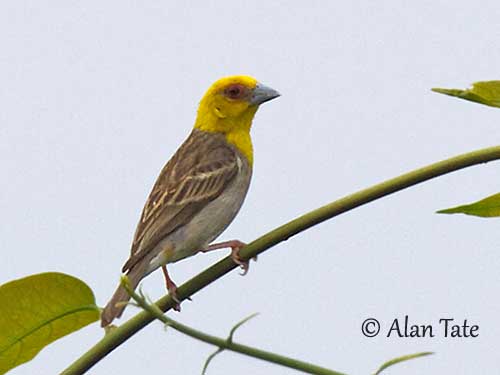
Ploceus sakalava
The Nelicourvi Weaver is also present on Madagascar. It is monogamous with long-term pair-bond. It is solitary nester and the nests are widely separated.
During the breeding season, the male calls loudly from horizontal branch while the slightly dropping wings are shivering. It performs similar display while the female does the nest lining.
The copulation occurs during the nest-building (observed on 6th day). The male guards the female against other males, and it may chase her during both nest-building and incubation.
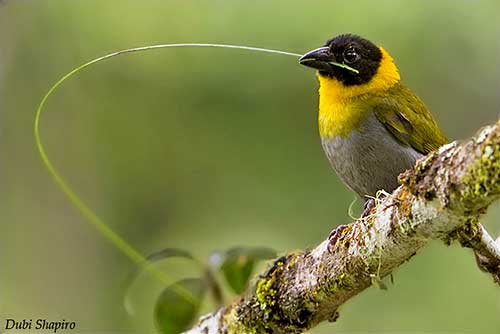
Ploceus nelicourvi
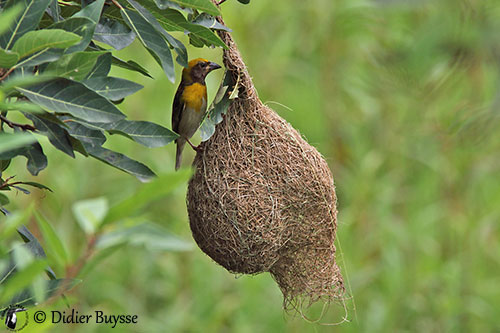
Baya Weaver
Ploceus philippinus
Then, the male builds the bowl and sometimes, the female may help by bringing some fine materials for the lining. The nest is often placed over water, suspended from thorny Acacia or from palm tree.
Some Asian weavers often add mud or wet dung to the nest structure. This fact is reported for only one African species, the Compact weaver.
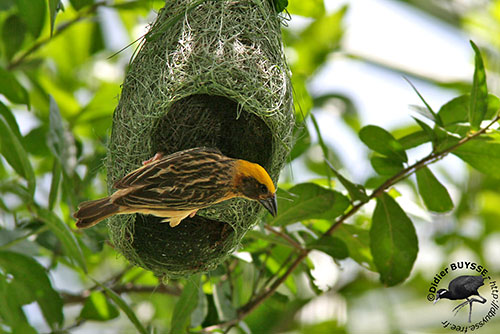
Baya Weaver
Ploceus philippinus
The genus Malimbus includes ten species whose nests are the most elaborate in the world. These birds are usually monogamous, solitary nesters and territorial. Some of them such as the Red-crowned Malimbe and the Cassin’s Malimbe may initiate co-operative nest-building, but then, the dominant male displaces the others and remains with the female.
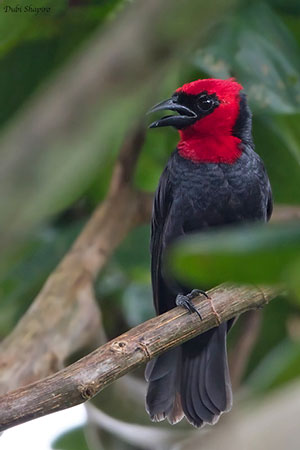
Crested Malimbe
Malimbus malimbicus
In this genus, the nest is usually built by the male, a retort-shaped structure with short to long entrance tunnel (8 to 25 centimetres long). It is made with woven fibres, strips of palm leaf, leaf petioles and vine fragments. A roof of two layers protects the nest from the rain. It is suspended from palm, or attached to spiny climbing palm.
Several nests are often built by some species.
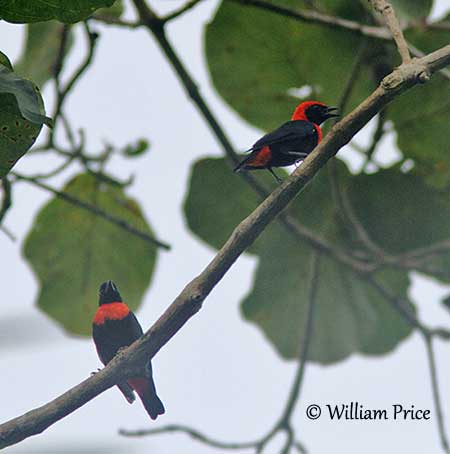
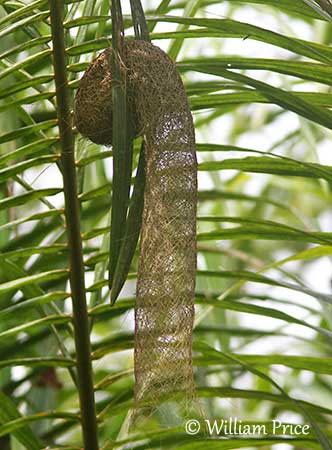
Such nest is suspended from two adjacent palm leaflets or the tips of the leaflets, in the high strata of the canopy, from six metres height to the upper canopy. The semi-transparent entrance tube may look delicate, but it is very robust. It is made with nicely woven palm fibres or vine tendrils. The bird arriving at nest in flight dives upwards into the tube with closed wings through the flared entrance. Then, it clambers up to the egg-chamber with its feet.
The Blue-billed Malimbe builds a ball-shaped nest with wide funnel-like entrance tube of 8 centimetres long and 4 centimetres in diameter, often at angle of 45 degrees. The tightness of weaving is very variable, and the nest sometimes resembles “flood debris caught in overhanging branches”. It is suspended from palm frond or small bush, 40 centimetres to 3 metres above forest stream or pool, rarely in dry part of the forest and then up to 10 metres above the ground.
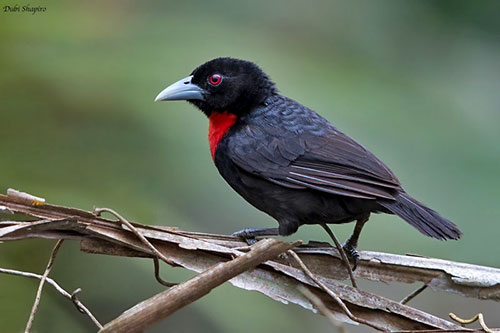
Blue-billed Malimbe
Malimbus nitens
The Red-headed Malimbe male has black plumage and scarlet forehead, crown and nape, extending from ear-coverts to neck sides. The female is similar, except on the head where the forehead is black.
This species is monogamous and solitary nester, or sometimes in small groups of up to 5 nests. The male defends the territory by chasing and calling.
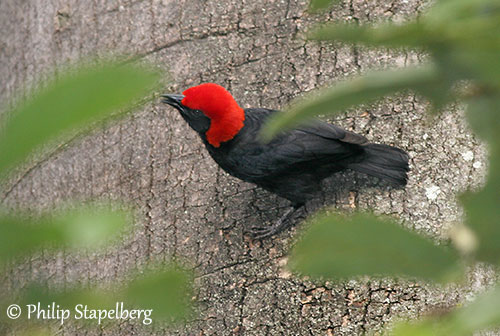
Red-headed Malimbe
Malimbus rubricollis
Male
During the courtship displays, the male chases the female and sings while bowing to her. These displays are performed away from the nest, usually in tree tops. Following this behaviour, nest-invitation display and courtship feeding occur, prior to copulation.
The nest is typically retort-shaped with wide entrance tunnel of 25 centimetres long. It is made with tendrils, grass blades and rootlets, but the egg-chamber is often unlined. Such nest is suspended from the top below a branch, about 6-30 metres high, although in primary forest, it is placed between 30 and 45 metres above the ground.
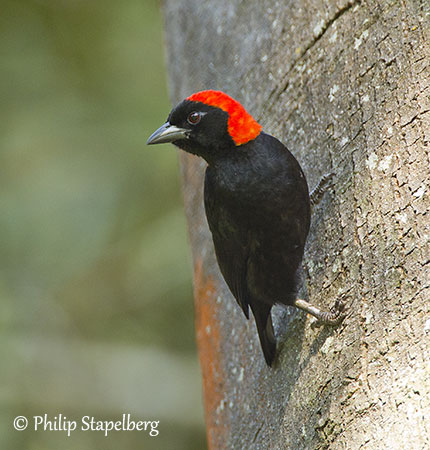
Red-headed Malimbe
Malimbus rubricollis
Female
The Red-headed Weaver of genus Anaplectes is a beautifully coloured weaver. Some authors include this species in the genus Malimbus, although several aspects of its plumage and nest represent a mixture of Ploceus and Malimbus.
The male is polygynous, but sometimes monogamous.
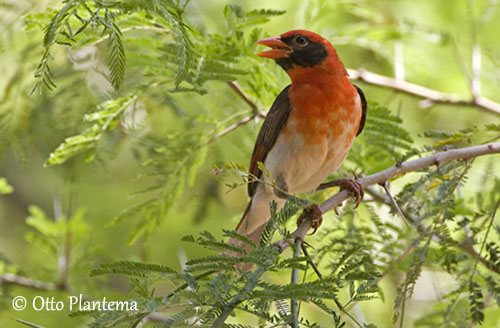
Red-headed Weaver
Anaplectes rubriceps
The nest is similar to the Ploceus nests, but it is made of flexible twigs, leaf petioles and tendrils whereas the nests of Ploceus weavers are usually made of green grass.
The nest is built by the male on a hanging branch above water, but also sometimes on a power-line.
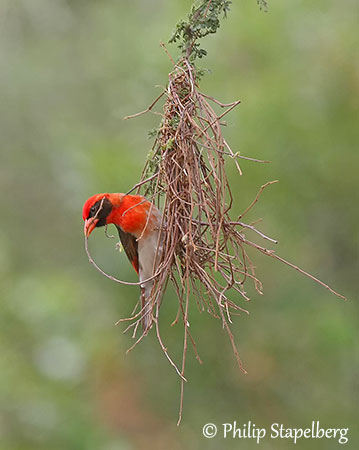
Red-headed Weaver
Anaplectes rubriceps
Once the nest is completed, a female attracted by the beautiful colours of male’s plumage, and especially the red head, inspects the nest. If she accepts it, she will make the lining with leaves. This is followed by mating.
However, if the female refuses the nest, the male usually destroys it and starts another one. It may build up to six nests during a breeding season.
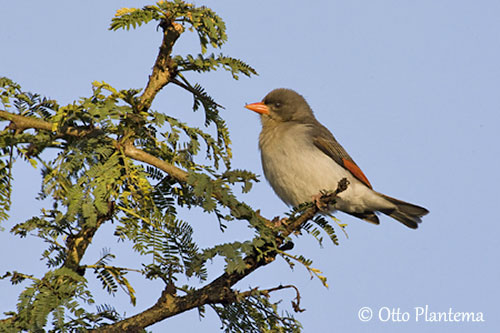
Red-headed Weaver
Anaplectes rubriceps
Female
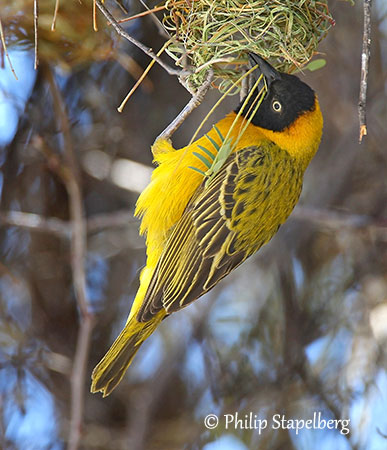
Egg colour varies depending on the species. However, the five Asian weavers lay plain white eggs. In the rest of the family, only 12 species have white eggs. Grey and brown eggs are rare. Usually, the eggs vary from plain blue or blue-green to white with markings or blue or greenish with markings.
The clutches tend to be small, with typically two eggs for numerous species, whereas clutches with more than three eggs are unusual. The size of the clutch also depends on the location. The birds of arid and semi-arid regions with variable weather conditions tend to lay 5-6 eggs. In South Africa, the clutch of the Village Weaver contains 2-4 eggs. In Central Africa, the clutch consists of 2 eggs.
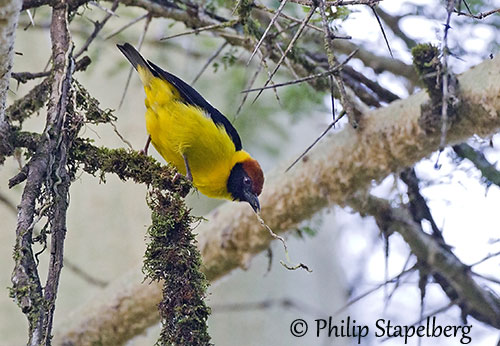
Brown-capped Weaver
Ploceus insignis
Most of the species have an incubation period of about 12-14 days but more information is needed. The smaller species weighing no more than 10-15 grams incubate during shorter period of about 10 days.
Adaptations have been observed, especially in the Red-billed Quelea which has a short incubation of 10-12 days. But this species breeds in huge colonies and usually, the breeding period is closely synchronized and the area may be occupied for less than 40 days in total.
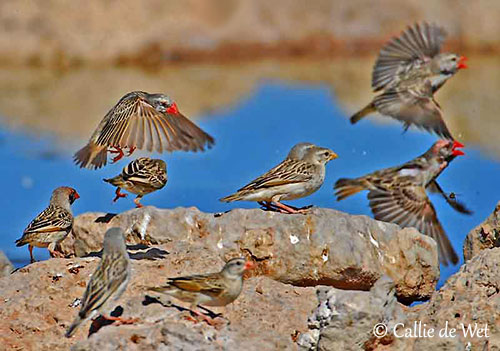
Red-billed Quelea
Quelea quelea
In the polygynous species, the female performs the incubation alone and she leaves the nest from time to time for feeding.
The males of polygynous species do not take part in chick-feeding, but individual variations exist.
Many families of both African and Asian weavers perform co-operative breeding, but this behaviour seems to be rare among the species of the sub-family Ploceinae.
The malimbes may show co-operative nest-building, but the helpers often leave when the nest is completely built.
Others species have dominant male and female with helpers. They help to feed the young and defend the territory.
Some “complex” arrangements are observed, with two males working together to defend several nests and assisting the females in chick-feeding.
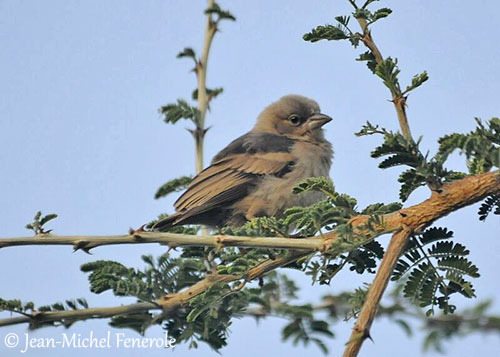
Grey-capped Social Weaver
Pseudonigrita arnaudi
Immature
The duration of the nestling period is difficult to determine, and some observations suggest that a period of 14-21 days is typical of this family. Usually, the chicks of the smaller species leave the nest earlier than those of larger birds.
Once fledged the young perch in the nesting trees and are still fed by the adults for about three weeks, until they become independent.
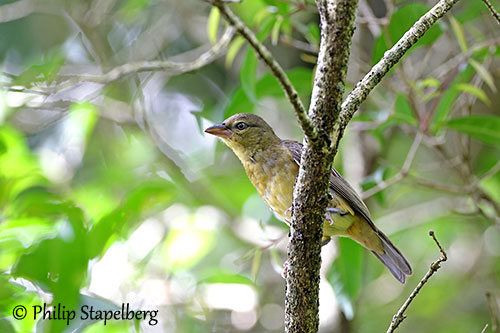
For most Ploceidae species, nest predation is the main threat reducing the breeding success.
Mammals, reptiles and avian predators may be attracted by large colonies, and leopards, monitor lizards, pythons, storks, eagles, rodents, egg-eating snakes and small hawks are the most usual predators depending on the range.
Many nests of forest-dwelling weavers are easy prey for predators.
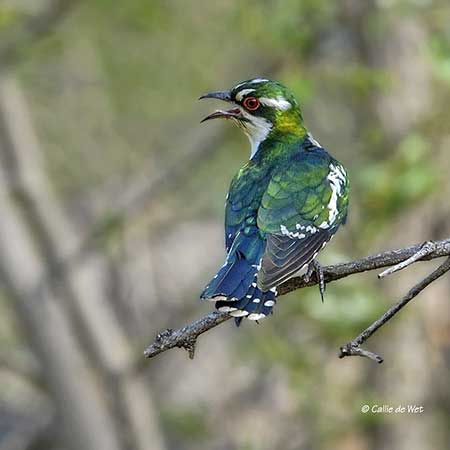
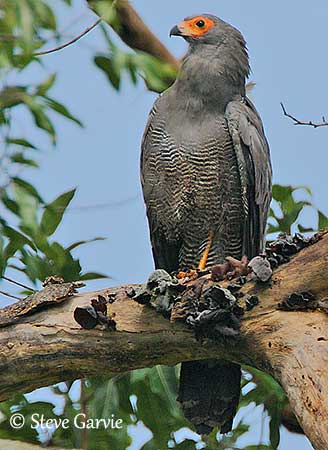
Polyboroides typus
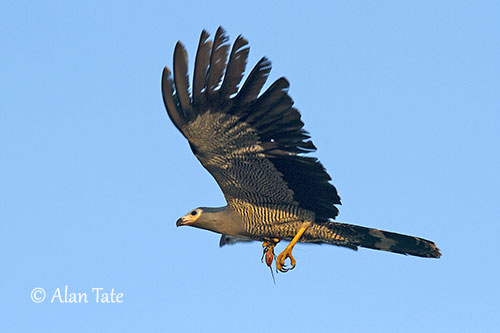
Polyboroides radiatus
On the other hand, the African Pygmy Falcon is often seen nesting in Sociable Weaver nests, but it may occasionally feed on chicks or young birds. Other species of barbets, chats, finches, tits and lovebirds enjoy the cosy nesting chambers.
But large birds such as vultures, owls and eagles may roost on the nest roof and even build their nest on the roof, using it as platform or support. Such numbers of residents is a kind of protection, with more eyes watching for danger.
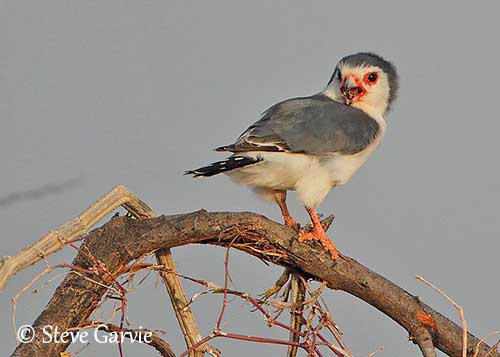
Polihierax semitorquatus
Birds often gain protection by nesting in association with Birds of Prey and biting or stinging insects such as bees, wasps and hornets, but also ants.
This behaviour resembles that of the Old World Sparrows. They often nest inside the large structure of the White Stork, and take advantage of this protection.
However, other problems come from the cuckoos. The Deiderik Cuckoo is a regular brood parasite. The young cuckoo ejects the chicks from the host’s nest, involving a total loss of breeding efforts for weavers.
The Ploceidae are primarily threatened by habitat loss caused by conversion of forests for agriculture expansion.
The island birds such as the Mauritius Fody are affected by introduced predator and reduction of the native forest.
In tropical Africa, several species lives in tiny forest fragments scattered across this region.
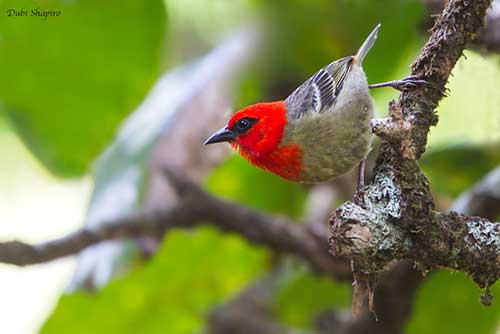
Foudia rubra
The Seychelles Fody is restricted to some islands in Seychelles archipelago. The population decline was caused by habitat loss and persecution by humans, because this species was considered a crop pest. But now, competition and predation from introduced species such as cats and rats are an important threat.
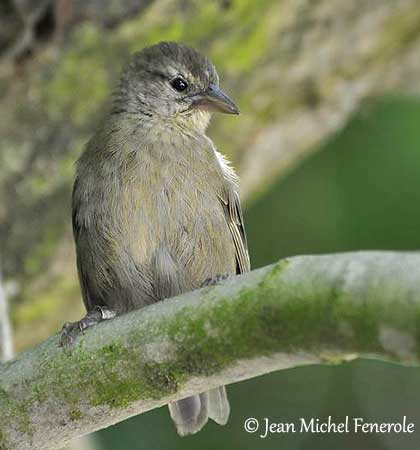
The weavers are often abundant and widespread in both natural and man-modified habitats. Some others live in specialized habitats and have a very restricted range. Habitat destruction involving forest clearance, intense grazing destroying the grasslands and conversion to agriculture reduce the populations which are severely fragmented and rapidly declining.
Persecution by humans is restricted to the species which are pests of cultivated grain or other crops.
Pet trade also remains a potential threat to numerous species.
Protection programs are in progress in several regions, including primarily the protection of the habitat.
These beautiful birds depend on their environment for feeding, nesting and rearing their chicks.
Their luminous plumage transforms them into rays of sunshine as they fly through the forest or over grassland. Nature needs them as they need it to live.
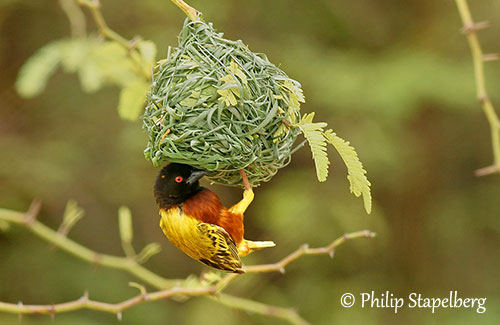
Jackson's Golden-backed Weaver
Ploceus jacksoni
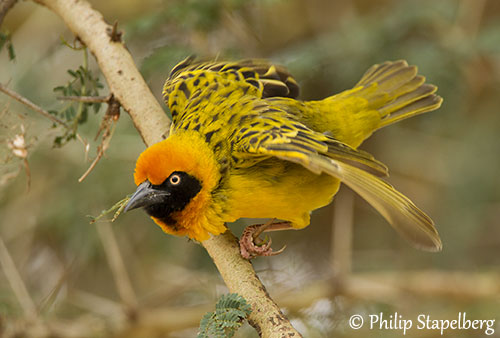
Speke's Weaver
Ploceus spekei